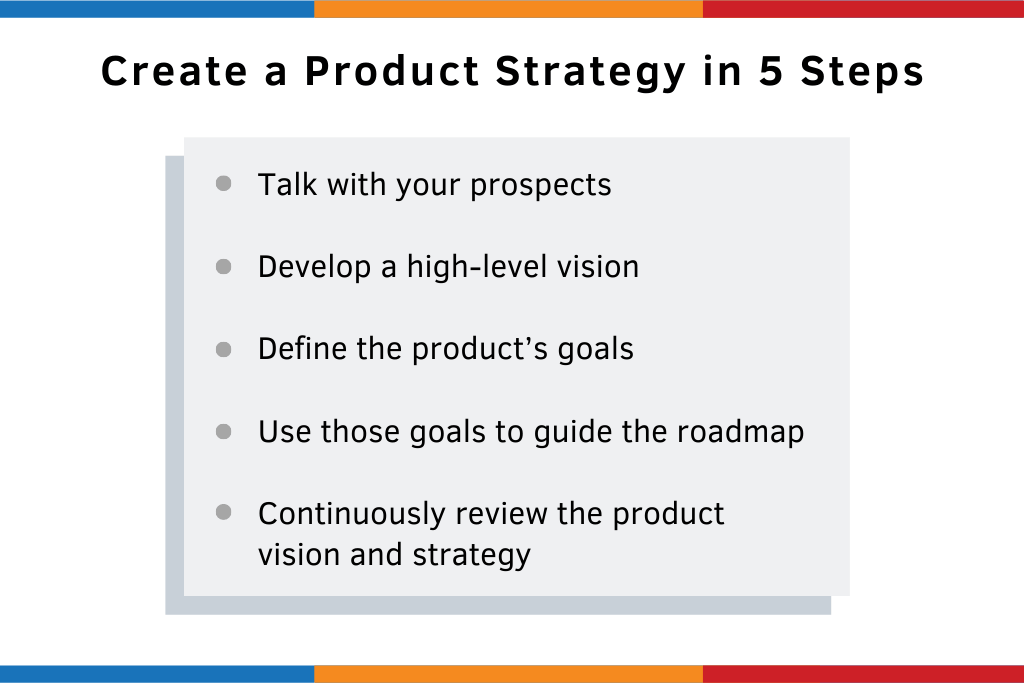Inspiration is a wonderful gift to a product manager—when it strikes. But like a lightning bolt, it’s difficult to know when, where, or how frequently inspiration will strike. And because inspiration—or your muse, or the lightbulb moment, or whatever you want to call it—makes a terribly unpredictable partner, you can’t count on it as the sole source of your product strategy.
Yes, you could sit around waiting for the next Facebook-sized product strategy to hit you. But truthfully, you’re about as likely to be struck by lightning.
What’s the real challenge with product strategy?
Product teams and executives rarely have a process for evaluating the right initiatives to build in the first place.
So if you’re responsible for developing a product strategy roadmap, you need a plan. I’m not talking about a rigid formula for the product itself. That would probably just yield a boring, uninspiring product. But you should have some sort of defined approach to developing a winning product strategy.
Or, if you’d prefer to think of it this way, you should follow a series of steps that will help you clear a path for inspiration to strike.
Here’s the battle-tested product strategy formula we recommend.
How to Create a Product Strategy in 5 Steps

What does this all look like in practice? Let’s explore a bit further.
1. Go talk to your prospects before defining your product strategy.
Many product managers, even highly experienced ones, try to develop their product strategy entirely internally. They talk to their executives. They brainstorm with their product and marketing teams. They pore over market data. And then, they…think really hard.
Yes, a talented and experienced product manager who has studied the market probably has some great ideas about where to take their company’s product.
But doesn’t this introspective approach misses the mark on a crucial element in developing a winning product strategy? What about the product’s user?
Where in your product strategy are your users?
In the bestselling business book, The Four Steps to the Epiphany, author Steve Blank makes the case that, “There are no facts inside your building…so get outside.”
Successful product teams have a process to evaluate market opportunities and reduce new product risks. Truly great product teams blend entrepreneurial instincts with the evidence they’ve gathered from the market to make intelligent product decisions. They have first built a culture to ask the right questions and validate opportunities objectively.
Before you get too far down the path of creating a product strategy and building a product roadmap based on your gut, your executive team’s thoughts, or even market research, go out and talk—and more important still, listen—to what your users tell you they want.
Download The Product Strategy Playbook ➜
2. Develop a high-level product vision before mapping out your product strategy.
After working with hundreds of product managers all over the world, we’ve learned this step is mission-critical to making your strategy a success.
There are actually three important benefits to starting with a high-level product vision and then working your way strategically down into the details.
- When you can articulate a compelling vision for your product, you’re more likely to earn executive approval you’ll to move forward (read more about this in Product Roadmaps: Your Guide to Planning and Selling Your Strategy).
- Being able to communicate your compelling product vision makes it more likely that others will play a role in your product’s success. Communicating with developers, marketing and sales teams, your industry’s analysts, and tastemakers—will share your enthusiasm for your product.
- When you’ve established your high-level product vision first, all of the decisions you and your team make regarding the product will have a more strategic basis.
3. Define your product’s goals.
This step might sound obvious, but many product teams fail even to take a stab at it. They’d rather throw feature ideas on the whiteboard.
After you’ve established a big-picture vision for your product, the next step in your plan should be to use that vision to determine a series of high-level objectives, specific things you want your product to accomplish.
You might determine that the most important thing your product could achieve would be to capture a new type of user persona and to increase the lifetime value of each customer.
Another way of thinking of these product goals is as key success metrics for your product—a way of gauging whether your product strategy is working or needs adjusting.
Once you have these goals in place—and, ideally, on a prioritized list of importance—you can then use them to inform your specific plans for features, functionality, and other aspects of the product you’re going to build.
4. Use your high-level product goals to guide your roadmap.
As you can probably see, we are moving top-down, one strategic level at a time, toward executing a product development plan. Start with a product vision that helps you shape your high-level product goals. Then, use those goals to help you determine what initiatives should make it onto your product roadmap.
Now that you’ve determined your most important strategic product goals, you are ready to translate those objectives into more concrete details about the product itself.
But what’s the process for this step? How can you tie your decisions about epics, themes, and other initiatives back to the product goals you outlined in the previous step?
I suggest you use a weighted-scoring model for the initiatives you’re considering adding to the product roadmap. Use the product goals you’ve established (“Customer Delight,” “Entry into a New Geographic Region,” etc.) as the guides for scoring each proposed new theme, epic, and feature. As you review a new epic, for example, you’ll score it against each of your product’s goals.
Prioritizing with a framework is a great way to ensure you make each decision about your product strategy on a truly strategic basis.
5. Check-in with your product’s vision to confirm your plan is on track.
At this point in your product strategy process, you have a compelling product vision that you can easily communicate.
You also have a series of well-defined goals for your product, which all reflect and support your product vision.
Moreover, you have a clear and strategically sound product roadmap. On your roadmap, every initiative is there for a reason. All initiatives also tie right back to your product goals. You’re ready to start development, with a solid plan.
But guess what? That solid plan, the one you’ve strategically established, is not going to be the exact route your product development process follows. As they do, things will change along the way. Things like: priorities, resource levels, competitor behavior, executive team patience.
Takeaways
So our final piece of advice for creating a winning product strategy is to periodically review the product vision and strategy you decided on early in your planning. I know it’s very easy to get pulled along in the current of day-to-day tasks, requests, and urgent issues that need your attention.
So, take a regular step back to make sure that the initiatives and priorities you’re working on right now still support the winning product strategy you worked so hard to create.




